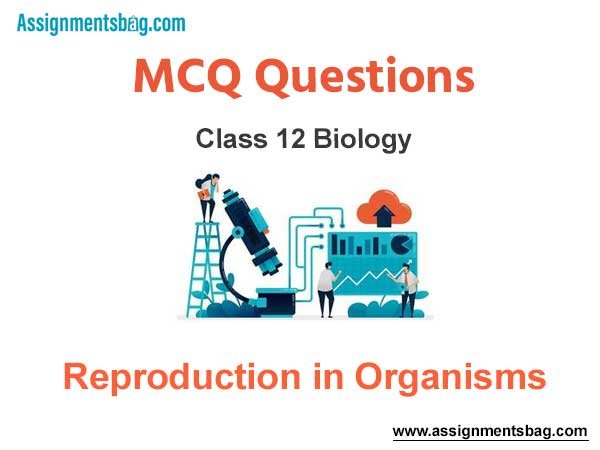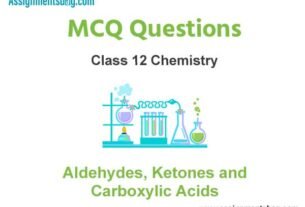Please refer to MCQ Questions Chapter 1 Reproduction in Organisms Class 12 Biology with answers provided below. These multiple-choice questions have been developed based on the latest NCERT book for class 12 Biology issued for the current academic year. We have provided MCQ Questions for Class 12 Biology for all chapters on our website. Students should learn the objective based questions for Chapter 1 Reproduction in Organisms in Class 12 Biology provided below to get more marks in exams.
Chapter 1 Reproduction in Organisms MCQ Questions
Please refer to the following Chapter 1 Reproduction in Organisms MCQ Questions Class 12 Biology with solutions for all important topics in the chapter.
MCQ Questions Answers for Chapter 1 Reproduction in Organisms Class 12 Biology
Question- Flowers are unisexual in
(a) China rose
(b) onion
(c) pea
(d) cucumber
Answer
D
Question- In some plants, the female gamete develops into embryo without fertilisation. This phenomenon is known as
(a) parthenogenesis
(b) autogamy
(c) parthenocarpy
(d) syngamy
Answer
A
Question- Vegetative propagation in mint occurs by
(a) offset
(b) rhizome
(c) sucker
(d) runner
Answer
C
Question- Which one of the following statements is not correct?
(a) Offspring produced by the asexual reproduction are called clone.
(b) Microscopic, motile, asexual reproductive structures are called zoospores.
(c) In potato, banana and ginger, the plantlets arise from the internodes present in the modified stem.
(d) Water hyacinth, growing in the standing water, drains oxygen from water that leads to the death of fishes.
Answer
C
Question- In ginger, vegetative propagation occurs through
(a) bulbils
(b) runners
(c) rhizome
(d) offsets
Answer
C
Question- Which one of the following pairs is wrongly matched while the remaining three are correct?
(a) Penicillium – Conidia
(b) Water hyacinth – Runner
(c) Bryophyllum – Leaf buds
(d) Agave – Bulbils
Answer
B
Question- In sexual reproduction, offsprings resemble the parents
(a) structurally but not functionally.
(b) functionally but not structurally.
(c) both structurally and functionally.
(d) neither structurally nor functionally.
Answer
B
Question- The “eyes” of the potato tuber are
(a) root buds
(b) flower buds
(c) shoot buds
(d) axillary buds
Answer
D
Question- During regeneration, modification of an organ to other organ is known as
(a) morphogenesis
(b) epimorphosis
(c) morphallaxis
(d) accretionary growth
Answer
B
Question- Vegetative reproduction of Agave occurs through
(a) rhizome
(b) stolon
(c) bulbils
(d) sucker
Answer
C
Question- Which of the following statements about animals that utilize external fertilization is incorrect ?
(a) They are divided equally between terrestrial and aquatic species.
(b) Many produce large numbers of gametes to ensure successful reproduction.
(c) The behaviours associated with mating are often highly synchronized.
(d) The probability of any one egg being fertilized and developing into an adult can be low.
Answer
A
Question- For union between stock and scion in grafting which one is the first to occur?
(a) Formation of callus
(b) Production of plasmodesmata
(c) Differentiation of new vascular tissues
(d) Regeneration of cortex and epidermis
Answer
A
Question- Which one of the following is correctly matched?
(a) Onion–Bulb
(b) Ginger–Sucker
(c) Chlamydomonas–Conidia
(d) Yeast–Zoospores
Answer
A
Question- Which of the following flowers only once in its lifetime?
(a) Bamboo species
(b) Jackfruit
(c) Mango
(d) Papaya
Answer
A
Question- Meiosis takes place in
(a) gemmule
(b) megaspore
(c) meiocyte
(d) conidia
Answer
C
Question- ‘Nothing lives forever, but life continues’. What does it mean?
(a) Older die but new are produced due to reproduction.
(b) Nothing can produce without death.
(c) Death has nothing to do with the continuation of life.
(d) Parthenogenesis is must for sexual reproduction.
Answer
A
Question-Which one of the following is monoecious?
(a) Marchantia
(b) Cycas
(c) Pinus
(d) Date palm
Answer
C
Question- Which one of the following plants is monoecious?
(a) Pinus
(b) Cycas
(c) Papaya
(d) Marchantia
Answer
A
Question- Which of the following pairs is not correctly matched? Mode of reproduction Example
(a) Binary fission Sargassum
(b) Conidia Penicillium
(c) Offset Water hyacinth
(d) Rhizome Banana
Answer
A
Question- The process of series of changes from larva to adult after embryonic development is called
(a) regeneration
(b) growth
(c) metamorphosis
(d) ageing
Answer
C
Question- Offsets are produced by
(a) meiotic divisions
(b) mitotic divisions
(c) parthenocarpy
(d) parthenogenesis
Answer
B
Question- The oestrous cycle is a characteristic of
(a) human females only
(b) mammalian females other than primates
(c) human males only
(d) mammalian males other than primates
Answer
B
Question- The terms homothallic and monoecious are used to denote
(a) bisexual condition
(b) unisexual condition
(c) staminate flowers
(d) pistillate flowers
Answer
A
Question- The sexual reproduction is absent in
(a) Spirogyra
(b) Nostoc
(c) Ulothrix
(d) Volvox
Answer
B
Question- Parthenogenesis is
(a) development of embryo without fertilisation
(b) development of fruit without fertilisation
(c) development of fruit without hormones
(d) development of embryo from egg without fertilisation
Answer
D
Question- The period from birth to the natural death of an organism represents
(a) gametophytic phase
(b) sporophytic phase
(c) life span
(d) life cycle
Answer
C
Question- Which ot the following has the longest life span ?
(a) Butterfly
(b) Crocodile
(c) Parrot
(d) Tortoise
Answer
D
Question- Which one of the following generates new genetic combinations leading to variation?
(a) Vegetative reproduction
(b) Parthenogenesis
(c) Sexual reproduction
(d) Nucellar polyembryony
Answer
C
Question- In all the methods of asexual reproduction
(a) offsprings produced are genetically identical to the parents.
(b) offsprings produced are genetically different from the parents.
(c) offsprings produced may or may not be identical to the parents.
(d) None of the above
Answer
A
Question- A clone is a group of individuals obtained through
(a) self-pollination
(b) hybridization
(c) asexual reproduction
(d) cross-pollination
Answer
C
Question- The term clone is used to describe such ___________and________ similar individual.
(a) chemically, genetically
(b) physiologically, chemically
(c) morphologically, genetically
(d) morphologically, metabolically
Answer
C
Question- Asexual reproduction is common among
(a) single celled organisms only.
(b) plants only.
(c) animals with simple organization.
(d) single celled animals, plants and animals with simple organizations.
Answer
D
Question- In protists and monerans, asexual reproduction occurs by
(a) budding
(b) binary fission
(c) conidia
(d) multiple fission
Answer
B
Question- Development of an egg without fertilization is called
(a) gametogenesis
(b) metagenesis
(c) oogenesis
(d) parthenogenesis
Answer
D
Question- In yeast cell division results in a small cell called
(a) bud
(b) clone
(c) branch
(d) offspring
Answer
A
Question- The term ‘Terror of Bengal’ is used for
(a) Bengal tiger
(b) water hyacinth
(c) algal bloom
(d) aquatic fauna
Answer
B
Question- In oogamy, fertilisation involves
(a) a small non-motile female gamete and a large motile male gamete
(b) a large non-motile female gamete and a small motile male gamete
(c) a large non-motile female gamete and a small non-motile male gamete
(d) large motile female gamete and a small nonmotile male gamete
Answer
B
Question- In which of the following pairs the plants can be vegetative propagated by leaf buds?
(a) Bryophyllum and Kalanchoe
(b) Chrysanthemum and Agave
(c) Agave and Kalanchoe
(d) Asparagus and Bryophyllum
Answer
A
Question- Why is vivipary an undesirable character for annual crop plants?
(a) It reduces the vigour of the plant.
(b) It adversely affects the fertility of the plant.
(c) The seeds exhibit long dormancy.
(d) The seeds cannot be stored under normal conditions for the next season.
Answer
D
Question- Oestrus cycle is seen in
(a) cows and sheep
(b) rats and deers
(c) dogs and tiger
(d) all of the above
Answer
D
Question- Product of sexual reproduction generally generates
(a) new genetic combination leading to variation
(b) large biomass
(c) longer viability of seeds
(d) prolonged dormancy
Answer
A
Question- Sexual reproduction can be grouped into _______ distinct states.
(a) two
(b) three
(c) four
(d) five
Answer
B
Question- In flowering plants both male and female gametes are non-motile. The method to bring them together for fertilization is
(a) water
(b) air
(c) pollination
(d) apomixis
Answer
C
Question- Syngamy means
(a) fusion of similar spores.
(b) fusion of gametes.
(c) fusion of dissimilar spores.
(d) fusion of cytoplasm.
Answer
B
Question- Which of the followings is a post-fertilization event in flowering plants ?
(a) Transfer of pollen grains
(b) Embryo development
(c) Formation of flower
(d) Formation of pollen grains
Answer
B
Question- Viviparity is found in
(a) whale
(b) lizards
(c) frogs
(d) birds
Answer
A
Question- Vegetative propagation in Pistia occurs by
(a) stolon
(b) offset
(c) runner
(d) sucker
Answer
B
Question- Which of the following statement about animal reproduction is incorrect ?
(a) Species that reproduce sexually cannot reproduce asexually.
(b) Viviparity, but not ovoviviparity, is common in mammals.
(c) Male insects can remove spermatophores deposited in a female by other males.
(d) Oogenesis and spermatogenesis both occur simultaneous in hermaphrodites.
Answer
A
Question- The end of vegetative phase in plants which marks the beginning of the reproductive phase can be easily seen in the higher plants when they come to
(a) flower
(b) fertilize
(c) pollinate
(d) None of the above
Answer
A

We hope you liked the above provided MCQ Questions Chapter 1 Reproduction in Organisms Class 12 Biology with solutions. If you have any questions please ask us in the comments box below.

